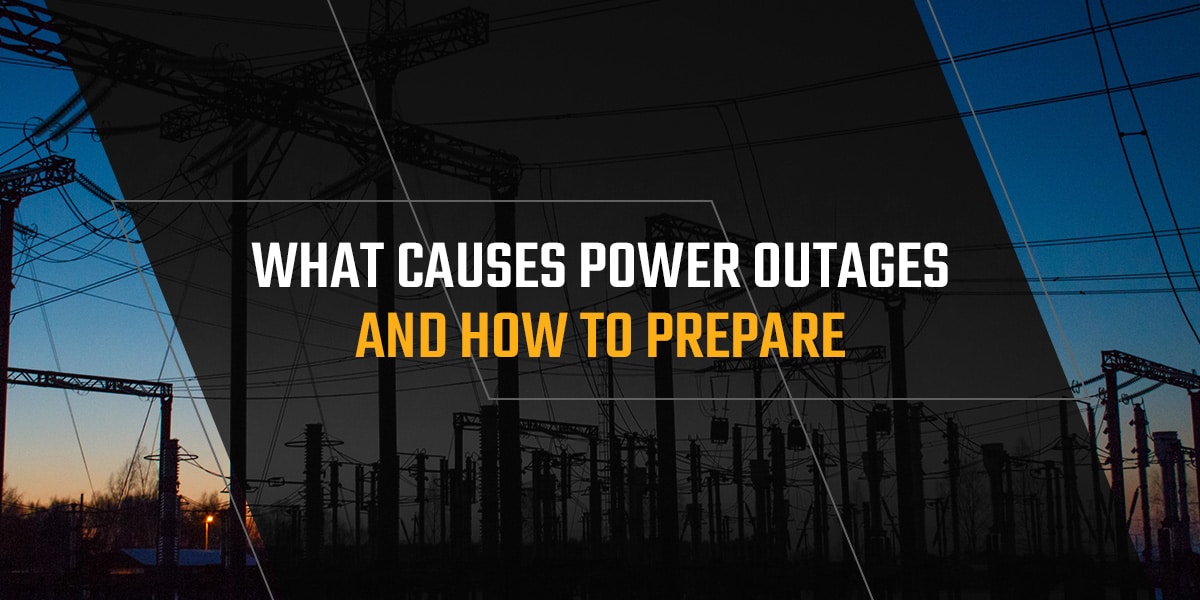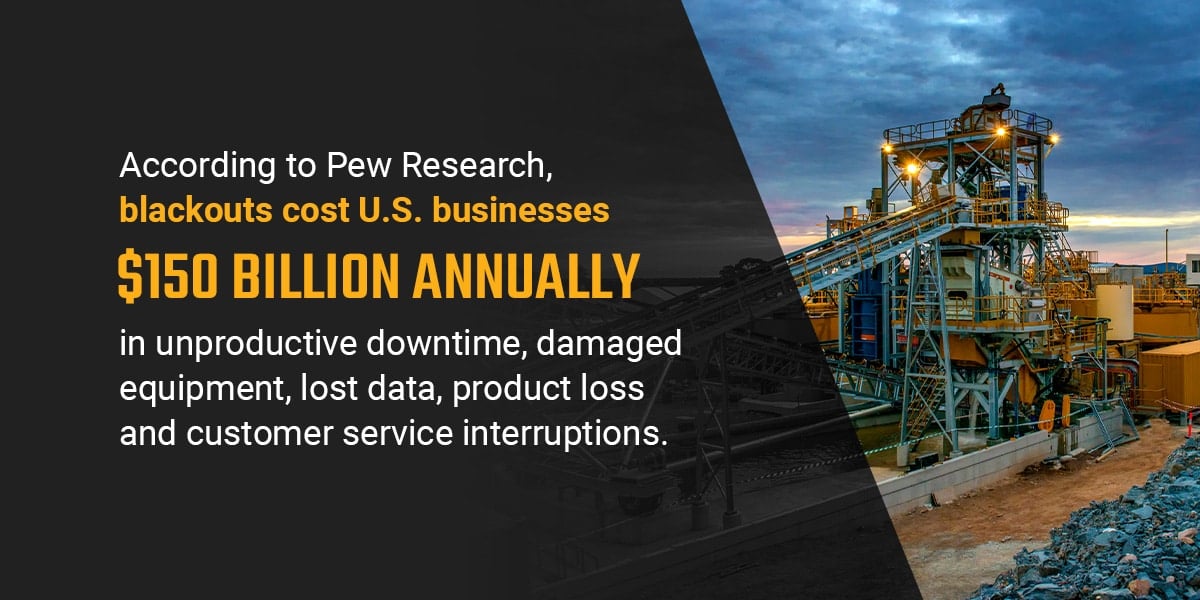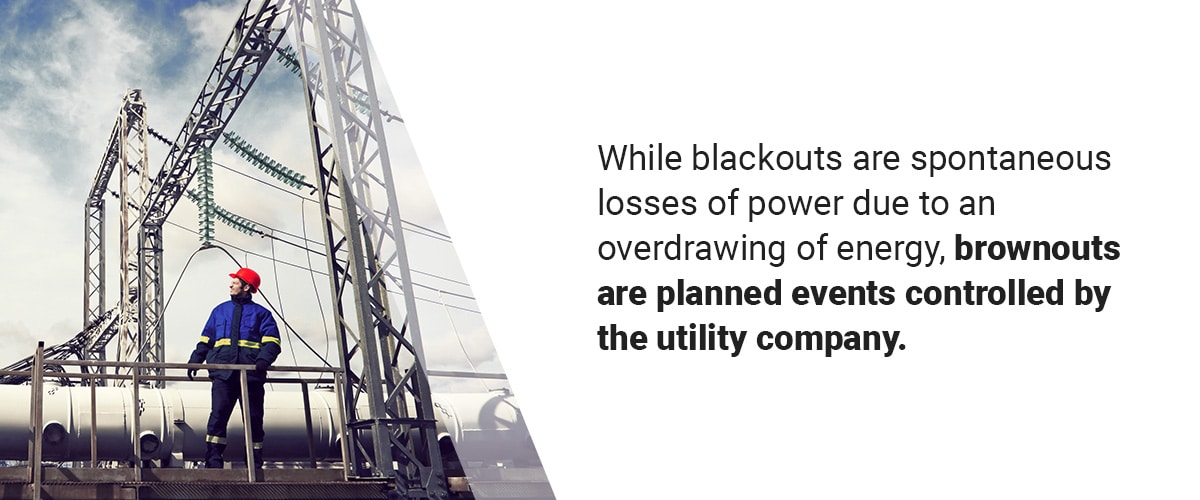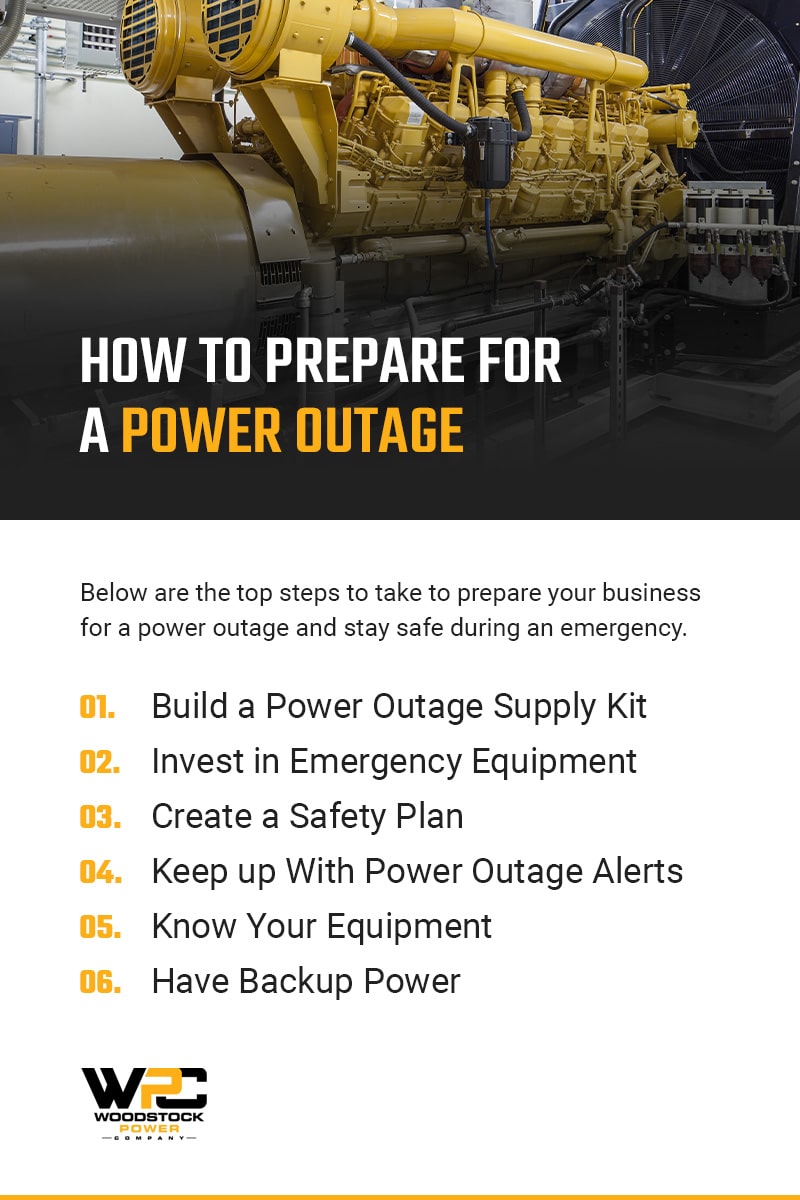What Causes Power Outages and How to Prepare

Power outages occur for various reasons. Depending on the time of year, where you live and the age of your local grid equipment, certain causes of power outages may be more common than others for your business.
Our guide to preparing for power outages covers some of the leading causes of power outages and how they can affect businesses. We also explore the differences between power blackouts and brownouts and provide actionable tips on preparing businesses for power loss to minimize safety and financial risks.
What Can Cause a Power Outage? 8 Common Causes
The average U.S. electricity customer experienced an estimated eight hours of power interruptions in 2020, up from an average of six hours in 2018. Depending on the nature of the power outage, a loss of business power supply can result in a significant loss of revenue and incur additional unplanned operating costs. According to Pew Research, blackouts cost U.S. businesses $150 billion annually in unproductive downtime, damaged equipment, lost data, product loss and customer service interruptions.
So, what causes power outages? From inclement weather patterns and wildlife interference to accidents and planned outages, many possible factors can affect your power supply, so it’s important to be prepared for any event. Below are the most common causes of power outages to be aware of.

1. Extreme Weather
Due to an increase in extreme weather events, power outages in the U.S. appear to be happening more frequently and for longer durations. In the early 2000s, power outages related to severe weather occurred at a rate of approximately 50 annually across the country. That number has risen to more than 100 outages annually on average for the past five years. Power outages are also now lasting an average of eight hours, severely disrupting residential households and businesses alike.
Some examples of the types of extreme weather that cause power outages include:
- High winds
- Lightning storms
- Freezing rain
- Ice formation on power lines
- Heavy snow
When inclement weather occurs, one of the primary reasons for a power outage is due to fallen tree branches contacting power lines. As high winds or heavy rain and snow pick up, it can cause dying or vulnerable tree branches to easily snap, sending them on a collision course with nearby power lines.
2. Natural Disasters
While extreme weather is one common cause of power outages, full-scale natural disasters can also cause power outages, though less frequently.
Some examples of how natural disasters cause power outages include:
- Wildfires ignite utility poles and burn up power lines instantly.
- Earthquakes upend power lines or send debris crashing into utility poles.
- Tornadoes cause a surge of high winds that knock over utility poles and lines or send debris into the lines.
- Floods wash away power infrastructure and can hurl large debris into utility poles, knocking them over.
Other types of natural disasters can also affect power availability, depending on the region. Mudslides, tidal waves and volcanic eruptions are also potential causes of power outages worldwide.
3. Wildlife
Wildlife interference is a major nationwide contributor to power outages, with birds and squirrels being the leading forms of wildlife responsible for disrupting power supplies. Rats, raccoons, snakes and even insects can also interfere with power lines.
In 2005, California’s then-Governor Arnold Schwarzenegger commissioned a study to estimate the costs of wildlife-related power outages to the state’s economy. The findings showed that wildlife-caused power outages were responsible for economic losses of between $32 and $317 million annually.
However, the losses due to wildlife-related power outages aren’t just financial. According to a 2014 study published in the scientific research journal PLOS One, up to 11.6 million birds may die annually from electrocution when colliding with power lines.
4. Vehicle Incidents
When a vehicle loses control or is hit by another vehicle, it may result in a collision with a nearby utility pole. When the collision is forceful enough, it may cause the pole to bend or come down entirely, downing the lines and other equipment. This incident type can occur with all vehicles, from cars and motorcycles to large trucks transporting cargo.
Driver impairment, distracted driving and poor driving conditions, such as ice and snow, can cause vehicle collisions with utility poles. Generally, this type of power outage only affects a small, local area and can be restored relatively quickly.
Many power lines hang over the road. Trucks and other taller vehicles can misjudge their size, causing their loads to catch on the cables and disrupt power flow.
5. Construction
Construction work, such as excavation or overhead hoisting activities can lead to power outages. One of the most preventable types of construction site accidents is when earthmoving equipment contacts underground cables, cutting the utility lines. Anyone planning to dig should contact the national 811 hotline to ensure it’s safe to dig in that location.
Another cause of construction-related power outages is when lift equipment contacts overhead power lines or knocks down utility poles. Other accidents, such as crane collapses or hoisted materials falling can also lead to power line damage and cause outages.
6. High Demand
Sometimes power outages are caused when there’s too much demand on the grid. These types of outages are most common during peak usage periods, including afternoons during heat waves. Residential homes and businesses draw a significant amount of energy operating air conditioners, heat pumps and fans to keep buildings cool.
When demand for power outweighs the available supply, the community could experience a brownout or blackout of the grid. Overburdened power lines, transformers and other equipment can fail due to a surge or being overheated. During heat waves, these components can fail when they begin to melt.
7. Equipment Failure
In a related type of power outage, equipment failure can occur when demand outweighs supply. In areas with older electrical infrastructure, aging equipment may suddenly cease to function or may not be able to maintain supplying power in high-demand areas.
Even within grids that are well maintained and up-to-date with high-quality equipment, failures can still occur. Problems with the cables, switches, connectors, transformers and other components can eventually lead to outages.
8. Planned Outages
Finally, outages can also occur due to planned maintenance. When parts of the grid need to be maintained, such as when components need to be replaced or repaired, utility companies alert customers to a window of time in which power will be unavailable. These planned outages keep both customers and workers safe.
During natural disasters, companies may also shut off the power supply as a preventive measure to keep people safe. While planned outages for maintenance occur during a fixed window of time, planned outages due to the potential for natural disasters can be prolonged and uncertain.

The Difference Between Power Brownouts and power Blackouts
Blackouts and brownouts are distinct grid-related power events that occur for different reasons and with varying effects. While blackouts are spontaneous losses of power due to an overdrawing of energy, brownouts are planned events controlled by the utility company.
Below is a comparison between a power brownout and a power blackout.
What Is a power Brownout?
When using the term brownout, most people refer to the deliberate, partial and short-term reduction in power supply to a partial portion of a grid for a fixed period of time. While this is the most common interpretation of the term, brownouts can also refer to the unintentional and sudden voltage sag that causes the noticeable dimming of lights or latent power supply to devices.
When referring to intentional or planned outages, brownouts have the following characteristics:
- Temporary: Brownouts are short-term stoppages in power controlled by utility companies that know when the brownout will begin and end.
- Partial: Brownouts don’t often affect the entire local grid, but rather are planned to affect certain isolated areas at a time, also known as a rolling brownout.
- Reduced capacity: During a brownout, there is only a reduction in power capacity rather than a complete loss of power.
- Intentional: Utility companies deliberately throttle the power supply, reducing the amount of voltage made available to certain portions of the grid. Brownouts are planned in advance, typically during strategic or peak times.
- Controlled: A planned brownout is completely controlled by the utility company, and they are the ones who can initiate the brownout and restore complete power.
- Preventive: Purposeful brownouts are done to prevent a full blackout in the future. They’re an emergency measure taken by the utility company to protect grid infrastructure and reduce the risk of costly power outages that occur due to too high power demands.
What Is a power Blackout?
Compared to a brownout, a power blackout is an unexpected and complete loss of grid power. During a brownout, you can still use your electrical devices but with a reduced power supply. During a blackout, no devices will work as there will be no power available. Sudden blackouts are caused by events such as storms or accidents, and they can last an indeterminate length of time.
Another term, “rolling blackout,” refers to a blackout that’s implemented by the utility company the same way a brownout is but instead of it being a partial loss of power, it’s a complete outage. These are often considered severe measures that utility companies take under extreme conditions whereby the grid could be severely impacted due to high demand. Rolling blackouts come with advanced notice.

How to Prepare for a Power Outage
Preparing for a power outage is essential to keeping your business running smoothly during an unexpected power interruption. Power outage preparation is also an essential safety precaution, helping you protect your people, products and equipment during an emergency.
Below are the top steps to take to prepare your business for a power outage and stay safe during an emergency.
1. Build a Power Outage Supply Kit
The first step in preparing for a power outage is to assemble an emergency supply kit. Power outages are unpredictable and can create inherent health and safety risks. Preparing for such emergencies means having the right supplies available when needed.
A power outage emergency supply kit for businesses should include items like:
- Non-perishable food
- Water
- First aid kit
- Flashlights with batteries
- Two-way radios
- Device battery packs and chargers
Ensure that power outage supplies are kept in an accessible location with supplies being clearly labeled. Because a power outage may occur in conjunction with a natural disaster, it’s essential to keep your supplies in solid, waterproof containers that will protect your items from moisture and damage. Also, be sure to routinely check that all supplies and food are in date.
2. Invest in Emergency Equipment
In addition to having basic emergency supplies, you’ll also need to equip your business with the right tools and devices necessary to continue operating through a power outage. Businesses should also invest in emergency equipment that can keep building occupants safe during an outage.
Some of the types of emergency equipment businesses may need during a power outage include:
- Surge protectors to prevent device-damaging power surges when grid power is restored.
- Emergency lighting that comes on automatically during an outage.
- Fire detectors that are battery-powered and can alert to fires that may occur in conjunction with emergencies that cause outages.
- Generators that provide a backup supply of power to operate essential equipment.
3. Create a Safety Plan
All commercial businesses and facilities should be prepared with a safety plan that protects employees and occupants during a power outage. Below are some of the points to include in your business safety plan for power outages:
- Exit the building using the building’s emergency exit corridors
- Establish a safety meeting point outside the building
- Use two-way radios to communicate with others
- Never access an electrical panel while standing in flood waters
- Stay a bus length away from downed power lines or potentially charged equipment
Keep in mind that depending on the cause of the power outage, the above safety protocols may not be sufficient to cover other safety factors related to natural disasters. Always follow local and state emergency protocols to ensure safety during natural disasters and consult a preparedness expert for specific emergency planning steps for businesses to take.
4. Keep up With Power Outage Alerts
Utility companies make power outage updates available to customers to access to stay abreast of news related to their community. Outage alerts let you know whether your current power outage is the result of a planned or unplanned event, which can help you decide which type of action to take, including whether to launch your business’s emergency plan.
You can sign up for power outage alerts by contacting your utility provider. Your utility company may also have other helpful resources for businesses and commercial facilities to help prepare for power outages and emergencies.
5. Know Your Equipment
Since most power outages are not planned, it’s important to be aware of how your business’s equipment can be impacted by a sudden loss and surge of power. Power surges can damage equipment if not handled properly during an outage. To protect your business assets, prepare your equipment by taking the following steps:
- Make a list of all the equipment you’ll need to turn off after an outage has occurred
- Know how each type of equipment, such as phones, servers and security systems, may be affected during a power outage by contacting the manufacturing or service provider
- Know how to properly reset equipment after an outage has occurred
If your business relies on expensive IT equipment, consider investing in an uninterrupted power supply (UPS). This allows you to protect your hard drives and other equipment in the event of residual power surges after an initial power outage.
6. Have Backup Power
Backup power supplies are the best way to stay in operation during a power outage and avoid costly downtime in business operations. Generators allow businesses to continue powering their vital equipment that’s necessary to maintain productivity.
When investing in a commercial business generator, be sure to calculate the amount of power your equipment and devices need and choose a generator size accordingly. You will also want to test out your generator before a power outage occurs to make sure that it’s sufficient in meeting your emergency power needs.
Prepare for a Power Outage With Woodstock Power
Keep your business prepared for a power outage with a generator from Woodstock Power Company. Power outages can cost businesses not just in revenue but in loss of business opportunities, liability, equipment and other risks. Having a reliable source of backup power is a crucial investment that can earn a return on investment every time there’s a power outage.
Woodstock Power is a leading provider of generator sales and installation expertise, and we’re available to help your business with your backup power needs. For more information about Woodstock Power generators available for your business, browse our commercial generators for sale. For assistance upgrading, installing or selecting the right generator, explore our range of generator services.
Contact Woodstock Power today to get in touch with a commercial generator expert. Fill out an online form or call 610-658-3242.


